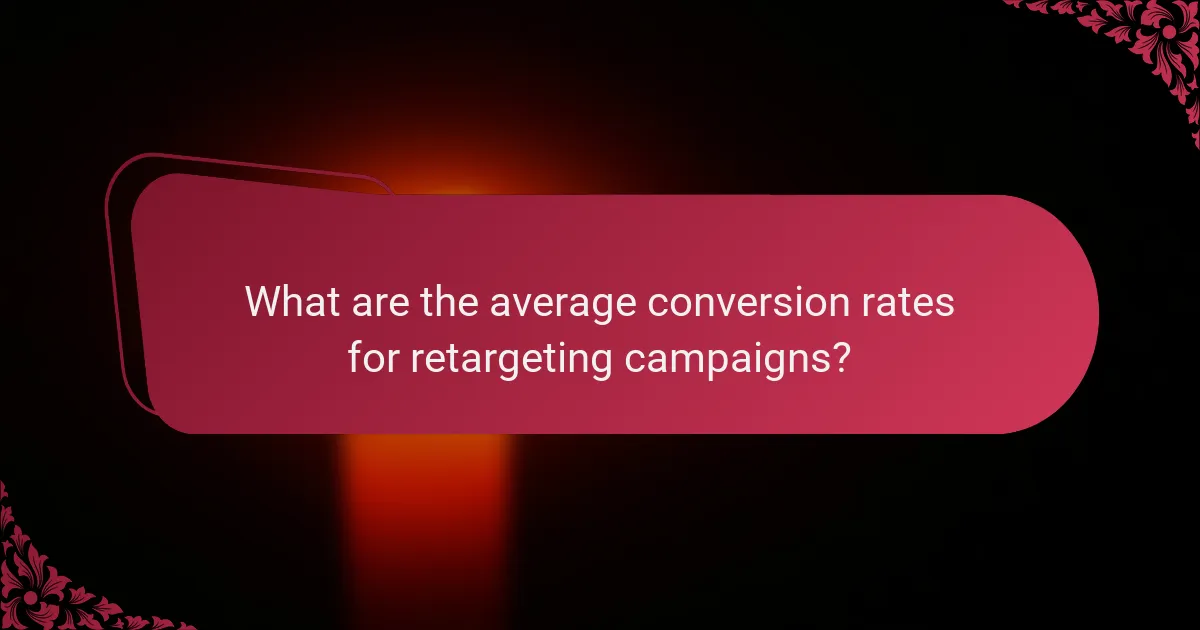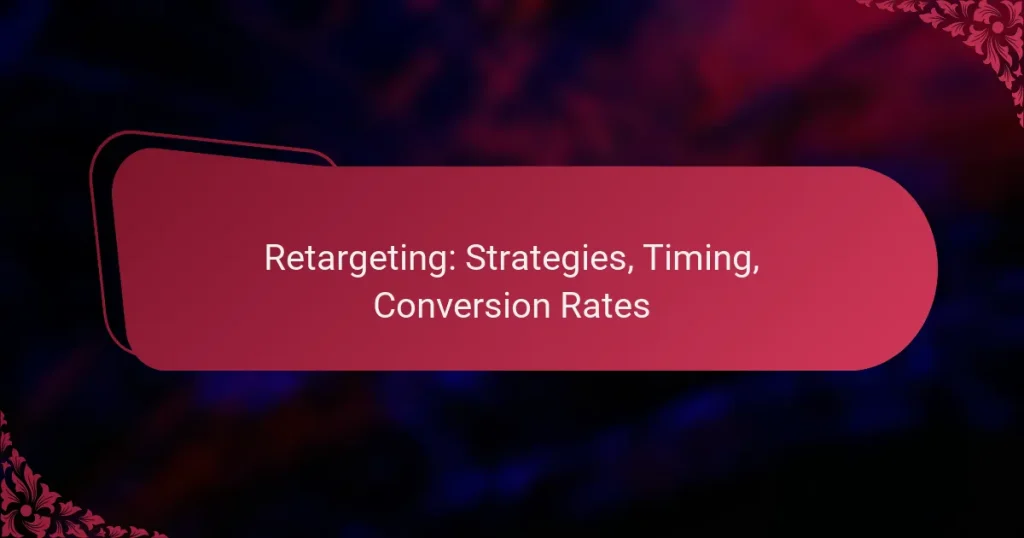Retargeting is a powerful marketing strategy that focuses on re-engaging users who have previously interacted with your brand, significantly enhancing conversion rates. By implementing effective techniques and paying attention to timing, advertisers can improve user engagement and overall campaign performance. With average conversion rates ranging from 2% to 10%, retargeting often outperforms standard display ads, making it a vital component of digital marketing efforts.

What are effective retargeting strategies for display advertising?
Effective retargeting strategies for display advertising focus on re-engaging users who have previously interacted with your brand. By utilizing various techniques, advertisers can enhance conversion rates and improve overall campaign performance.
Dynamic retargeting
Dynamic retargeting involves displaying personalized ads based on users’ previous interactions with specific products or services. This strategy uses data from user behavior to show relevant items, increasing the likelihood of conversion.
For example, if a user viewed a pair of shoes on an e-commerce site, dynamic ads can showcase those shoes along with similar options. This personalized approach can lead to significantly higher engagement rates.
Segmented audience targeting
Segmented audience targeting divides your audience into distinct groups based on behavior, demographics, or interests. This allows for more tailored messaging that resonates with each segment, improving the effectiveness of your retargeting efforts.
For instance, you might create separate campaigns for users who abandoned their shopping carts versus those who browsed but did not purchase. Tailoring your approach can enhance relevance and drive conversions.
Cross-device retargeting
Cross-device retargeting ensures that your ads reach users across multiple devices, such as smartphones, tablets, and desktops. This strategy recognizes that consumers often switch devices during their buying journey, and it helps maintain brand visibility throughout.
Implementing cross-device tracking can help you serve consistent ads to users, regardless of the device they are using. This can lead to improved brand recall and higher chances of conversion.
Personalized ad creatives
Personalized ad creatives are tailored to reflect the interests and behaviors of individual users. By utilizing data such as past purchases or browsing history, advertisers can craft messages that resonate more deeply with potential customers.
For example, including the user’s name or showcasing products they have previously viewed can create a more engaging experience. Personalized ads often see better click-through rates compared to generic ones.
Sequential retargeting
Sequential retargeting delivers a series of ads in a specific order to guide users through the conversion funnel. This method can help tell a story or provide additional information that encourages users to take action.
For example, the first ad might remind users of a product they viewed, the second could offer a discount, and the third might highlight customer testimonials. This strategic approach can effectively nurture leads and boost conversion rates.

How does timing impact retargeting success?
Timing plays a crucial role in the effectiveness of retargeting campaigns. The right timing can significantly enhance user engagement and conversion rates by addressing potential customers when they are most receptive.
Immediate retargeting
Immediate retargeting involves displaying ads to users shortly after they visit your website or interact with your content. This strategy capitalizes on the user’s recent interest, keeping your brand top-of-mind. For example, if a user views a product but doesn’t purchase, showing them an ad within minutes can prompt them to reconsider.
To implement immediate retargeting effectively, set up your campaigns to trigger ads as soon as a user leaves your site. This approach can lead to higher conversion rates, often in the range of 10-30% for well-targeted ads.
Delayed retargeting
Delayed retargeting occurs when ads are shown to users after a certain period has passed since their last interaction. This strategy can be useful for nurturing leads who may need more time to make a decision. For instance, showing ads a few days or weeks later can remind users of their interest without overwhelming them.
When using delayed retargeting, consider the typical buying cycle for your products or services. For high-involvement purchases, a longer delay may be appropriate, while for low-cost items, a shorter timeframe might be more effective.
Frequency capping
Frequency capping limits the number of times a user sees your retargeting ads within a specific timeframe. This practice helps prevent ad fatigue, which can occur if users are bombarded with the same message repeatedly. Setting a cap of 3-5 impressions per week is a common approach.
To implement frequency capping, use your ad platform’s settings to specify limits. Monitor engagement metrics to adjust your strategy as needed, ensuring that your ads remain effective without becoming intrusive.

What are the average conversion rates for retargeting campaigns?
The average conversion rates for retargeting campaigns typically range from 2% to 10%, depending on the industry and the effectiveness of the strategy employed. Retargeting allows businesses to re-engage users who have previously interacted with their brand, often resulting in higher conversion rates compared to standard display ads.
Industry benchmarks
Conversion rates for retargeting campaigns vary significantly across different industries. For example, e-commerce businesses often see rates between 5% and 10%, while B2B companies may experience lower rates, typically around 2% to 5%. Understanding these benchmarks can help set realistic expectations for campaign performance.
Additionally, sectors like travel and hospitality tend to achieve higher engagement, sometimes exceeding 10%, due to the nature of their offerings and the emotional connection involved in travel planning.
Factors influencing conversion rates
Several factors can influence the conversion rates of retargeting campaigns. The quality of the ad creative, the relevance of the product to the audience, and the timing of the retargeting efforts all play crucial roles. Ads that are visually appealing and tailored to the user’s previous interactions tend to perform better.
Moreover, the frequency of ad exposure can impact user fatigue. Striking a balance between visibility and overexposure is essential to maintain user interest without causing annoyance.
Case studies of successful campaigns
Many brands have successfully leveraged retargeting to boost their conversion rates. For instance, an online fashion retailer implemented a retargeting strategy that included personalized product recommendations based on browsing history, resulting in a 15% increase in conversions over three months.
Another example is a software company that used retargeting ads to remind users of their abandoned sign-up process, achieving a conversion rate of 8% by offering a limited-time discount. These case studies highlight the effectiveness of targeted messaging and strategic timing in retargeting efforts.

What prerequisites should be considered for retargeting?
Successful retargeting requires a solid foundation of website traffic and effective data collection methods. Understanding these prerequisites helps in creating targeted campaigns that can significantly improve conversion rates.
Website traffic requirements
To effectively implement retargeting, your website should attract a minimum amount of traffic, typically in the low hundreds or thousands of visitors per month. This volume ensures that there is a sufficient audience for your retargeting efforts.
Consider focusing on quality traffic over sheer numbers. Engaging visitors who are genuinely interested in your products or services increases the likelihood of conversions during retargeting campaigns.
Data collection methods
Effective retargeting relies on robust data collection methods to track user behavior on your website. Implementing tools like Google Analytics or Facebook Pixel can help gather insights on visitor interactions and preferences.
Ensure compliance with data protection regulations, such as GDPR in Europe or CCPA in California, when collecting user data. Transparency with users about how their data is used can enhance trust and improve the effectiveness of your retargeting strategies.

How can businesses measure retargeting effectiveness?
Businesses can measure retargeting effectiveness by analyzing key performance indicators (KPIs) and utilizing attribution models. These metrics help determine how well retargeting campaigns convert users and the overall return on investment (ROI).
Key performance indicators
Key performance indicators for retargeting include metrics such as click-through rates (CTR), conversion rates, and cost per acquisition (CPA). A high CTR indicates that the ads are engaging, while a strong conversion rate shows that users are taking desired actions after seeing the ads.
For instance, a typical conversion rate for retargeting campaigns can range from 2% to 10%, depending on the industry and the effectiveness of the ad content. Monitoring these KPIs regularly allows businesses to adjust their strategies for better results.
Attribution models
Attribution models help businesses understand the impact of retargeting within the customer journey. Common models include last-click attribution, where the final touchpoint is credited for the conversion, and multi-touch attribution, which distributes credit across all interactions.
Using multi-touch attribution can provide a more comprehensive view of how retargeting contributes to conversions. For example, if a user first interacts with a brand through a display ad and later converts after seeing a retargeting ad, both touchpoints would receive credit in a multi-touch model.

What are the emerging trends in retargeting?
Emerging trends in retargeting focus on personalization, cross-device strategies, and the use of artificial intelligence. Advertisers are increasingly leveraging data to create tailored experiences that resonate with users, enhancing engagement and conversion rates.
Personalization in Retargeting
Personalization is crucial in retargeting, as it allows brands to deliver relevant ads based on user behavior and preferences. By analyzing past interactions, businesses can create customized messages that appeal to individual interests, leading to higher engagement.
For example, an online retailer might show ads for products a user viewed but didn’t purchase, along with complementary items. This approach can significantly increase the likelihood of conversion, as it taps into the user’s existing interests.
Cross-Device Retargeting
Cross-device retargeting enables advertisers to reach users across multiple devices, ensuring a seamless experience. This strategy recognizes that consumers often switch between smartphones, tablets, and desktops during their shopping journey.
Implementing a cross-device strategy involves tracking user behavior across platforms and delivering consistent messaging. Brands can use tools like Google Ads or Facebook Ads to manage campaigns effectively, increasing the chances of converting users who may abandon their carts on one device but return on another.
Artificial Intelligence in Retargeting
Artificial intelligence (AI) is transforming retargeting by automating ad placements and optimizing campaigns in real-time. AI algorithms analyze vast amounts of data to identify patterns and predict user behavior, allowing for more effective ad targeting.
For instance, AI can adjust bids based on the likelihood of conversion, ensuring that ad spend is allocated efficiently. This technology not only enhances performance but also helps marketers stay agile in a rapidly changing digital landscape.


